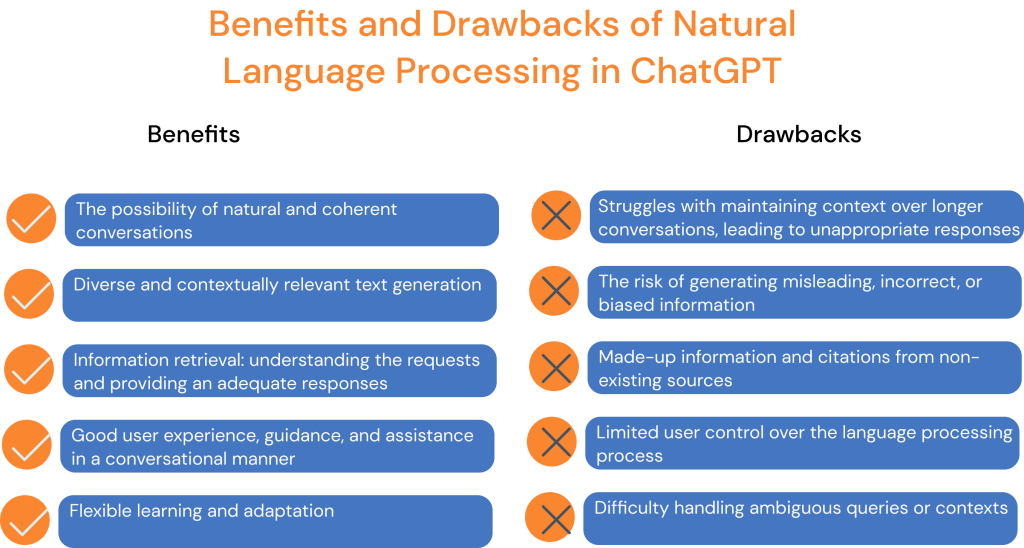In the intricate realm of artificial intelligence (AI), one new facet stands out as a crucial bridge between human communication and how they understand machines: Natural Language Processing (NLP). This sophisticated field lies at the confluence of computer science and linguistics, empowering computers to comprehend and interpret text and spoken language much like humans do. As you embark on a journey to unravel the intricacies of NLP, you will delve into its significance and mechanisms, discover what is a Natural Language Processing in real-world terms, and shed light on why students need to grasp its principles.
Natural Language Processing is AI that traces its roots to the 1950s when Alan Turing introduced the Turing Test as a criterion for determining a computer’s intelligence based on its natural language interpretation. Over the decades, NLP value and operations transitioned from rules-based AI tools and systems to statistical approaches, eventually embracing data-driven methodologies.
In recent years, new deep learning, a subset of AI, has become instrumental in NLP advancements. Deep learning models, powered by convolutional neural networks (CNNs) and recurrent neural networks (RNNs), enable NLP systems to learn and adapt dynamically, extracting meaning from vast and unlabeled data sets.
What Is Natural Language Processing?
What is natural language processing? Natural Language Processing is a type of AI that stands at the intersection of computer science and artificial intelligence, aiming to equip computers with the ability to comprehend text and spoken language akin to humans understanding.
Still, in the context of artificial intelligence, well-crafted algorithms strive to elicit nuanced meanings from diverse linguistic expressions. Namely, NLP is a multifaceted field incorporating computational linguistics, rule-based modeling, statistical analysis, machine learning, and deep learning. These technologies empower computers to recognize words and grasp the nuances of human language, deciphering intent, sentiment, and meaning.
Natural Language Processing: Why Do Students Need to Know About It?
Here are just a few of the factors why students may need natural language processing:
- To understand the logic behind AI detectors. Understanding what is Natural Language Processing is crucial for students because it unveils the underlying logic of AI detectors.
- To understand complicated modern technologies. AI detectors, the backbone of many advanced applications, rely on NLP to comprehend and respond to human language. Whether it’s a new voice-operated GPS system, a digital assistant, or a customer service chatbot, NLP is at the core, allowing these systems to interpret user commands, answer questions, and perform complex language-related brainstorming tasks
- To understand human-machine interactions. For academic students, delving into the realm of NLP provides a unique opportunity to grasp the intricacies of human-machine interaction.
- To enter the business of industrial fields. As the NLP model plays an increasingly vital role in enterprise solutions, understanding its principles can give students a competitive edge in fields such as business operations, employee productivity, and mission-critical processes.
- To prepare for the upcoming technologies. Moreover, familiarity with Natural Language Processing lays the foundation for exploring broader AI applications, fostering a comprehensive understanding of the transformative potential of natural language processing.
How Does Natural Language Processing Work in Various Fields?
How does natural language processing work? Human language is nuanced, posing significant challenges for computers aiming to decipher meaning accurately. NLP tackles this complexity through various tasks:
- Speech Recognition. This involves converting spoken words into text, a crucial task for applications that respond to voice commands.
- Part of Speech Tagging. Determining the grammatical category of each word based on its usage and context.
- Word Sense Disambiguation. Selecting the correct meaning of a word with multiple interpretations based on context.
- Named Entity Recognition (NER). Identifying words or phrases as entities, such as locations or names.
- Coreference Resolution. Identifying when two words refer to the same entity, a task extending beyond pronouns to include metaphors and idioms.
- Sentiment Analysis. Extracting subjective qualities like attitudes and emotions from text.
- Natural Language Generation (NLG). Converting structured information into human language.

NLP tools and approaches
Python, coupled with the Natural Processing Language tool – Natural Language Toolkit (NLTK), emerges as powerful tools for addressing NLP tasks. NLTK encompasses libraries for tasks like part of speech tagging, word segmentation, stemming, lemmatization, and tokenization, aiding in the breakdown of complex language data.
As NLP evolved, statistical approaches, machine learning, and deep learning models entered the scene. The marriage of these technologies allows Natural Language Processing systems to learn from vast amounts of unstructured data, enabling them to continually enhance their understanding and accuracy over time.
Natural Language Processing benefits
Natural Language Processing in AI yields a multitude of benefits, enhancing human-computer communication and facilitating various applications:
- Improved Accuracy and Efficiency. Natural Language Processing work enhances the accuracy and efficiency of documentation, making it easier to process and understand large volumes of text.
- Automatic Summarization. Natural Language Processing work allows for the automatic creation of readable summaries from complex original texts, aiding in quick comprehension.
- Enhanced Personal Assistants. Personal assistants like Alexa leverage Natural Language Processing to understand spoken words, making interactions more intuitive for users.
- Chatbot-Driven Customer Support. Organizations leverage NLP to implement chatbots for efficient and context-aware customer support.
- Sentiment Analysis. Natural Language Processing work enables businesses to perform sentiment analysis, extracting valuable insights from the vast pool of textual data.
- Advanced Analytics. NLP unlocks advanced insights from analytics, allowing any organization to glean information that was previously challenging due to data volume.
Natural Language Processing Examples and Cases
Large foundation models, such as GPT-3, may generalize a large number of tasks without any task-specific training. The latest advancements in this technology represent an important step toward human-level generalization and general artificial intelligence, which are the ultimate aims of most AI research, including those at OpenAI and Google’s DeepMind.
Such systems that have been involved contain enormous disruptive potential, which might result in exponential AI-driven economic development, dramatically transforming industry and society. While you may remain skeptical of profoundly transformational AI, such as artificial general intelligence and language processing, it is vital for organizational leaders to be aware of early indicators of development owing to its enormous disruptive potential.
Other Natural Language Processing examples use cases
- Spam Detection
While spam detection may not immediately be associated with NLP, it heavily relies on NLP’s text classification capabilities. Natural Language Processing aids in scanning emails for linguistic patterns indicative of spam, including grammar issues, overuse of financial terms, and inappropriate urgency.
- Machine translation
Google Translate exemplifies the application of the Natural Language Processing language model in machine translation. Effective translation extends beyond word replacement, requiring capturing the nuanced meaning and tone of the input language for accurate and impactful output.
- Virtual agents and chatbots
Virtual agents like Siri and Alexa leverage speech recognition and natural language generation to understand and respond to voice commands. Chatbots, operating through typed text, employ similar Natural Language Processing magic, learning contextual clues for improved responses over time.
- Social media sentiment analysis
Natural Language Processing proves indispensable in gleaning insights from social media. Sentiment analysis decodes language in posts, reviews, and responses, providing companies with valuable information for product development, advertising, and event planning.
- Text summarization
Text summarization, a significant Natural Language Processing application, utilizes techniques to digest extensive text volumes into concise summaries. This aids in generating indexes, research data bases, and catering to time-constrained readers.

Techniques and methods of Natural Language Processing AI
NLP involves utilizing syntax and semantic analysis:
- Syntax
Syntax includes the arrangement of words in a sentence to convey grammatical sense. Natural Language Processing employs techniques such as parsing, word segmentation, sentence breaking, morphological segmentation, and stemming to analyze and understand the structure of sentences.
- Semantic analysis
Semantics delves into the meaning behind words. NLP deploys algorithms for word sense disambiguation, named entity recognition, and natural language generation to comprehend and generate meaningful text.
AI Natural Language Processing challenges
While AI natural language processing has witnessed remarkable progress, several challenges persist:
- Precision. Computers demand precise and unambiguous language, which contrasts with the inherent ambiguity and variability of human speech.
- The tone of voice and inflection. Recognizing subtle nuances, including sarcasm and changes in tone, remains a challenge for Natural Language Processing algorithms.
- Evolving use of language. Language continually evolves, presenting a moving target for NLP systems that rely on established rules.
Q&A about NLP
Q: What distinguishes speech recognition from other NLP tasks?
A: Speech recognition, also known as speech-to-text, focuses on converting spoken words into text data, presenting unique challenges due to the variability in speech patterns, accents, and grammar.
Q: How does NLP contribute to sentiment analysis?
A: Sentiment analysis, a key Natural Language Processing task, aims to extract subjective qualities from text, helping businesses understand customer attitudes, emotions, and opinions expressed in social media posts, reviews, and more.
In a world where language is both an art and a science, NLP emerges as the bridge, connecting the intricate tapestry of human communication with the binary language of machines. Embracing the principles and applications of Natural Language Processing is not just a scholarly pursuit; it is even an essential step in navigating the future landscape of artificial intelligence.
